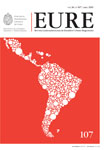Legitimidad espacial: un análisis de la mutación y la permanencia de las estructuras espaciales urbanas
DOI:
https://doi.org/10.4067/S0250-71612010000100006Palabras clave:
estructura urbana, mercado inmobiliario, morfología urbanaResumen
El propósito de este ensayo es mostrar cómo ciertos procesos de integración vertical -sobre todo en aquellas zonas de las ciudades que se han convertido en soportes físicos de significados compartidos, y por tanto, convertidas así en espacios simbólicos- causan la desaparición de determinadas organizaciones espaciales urbanas, socavando los principios que rigen las prácticas sociales de estas personas, entre ellos los relativos a la apropiación del espacio. Para esto, se trabajó con la hipótesis de que estos procesos verticales no son espacialmente legítimos. Las referencias teóricas provienen, principalmente, de Norberto Bobbio y Max Weber. Para desentrañar, empíricamente, la existencia de esta hipótesis, se eligió la zona urbana de Casa Forte, en Recife, en el noreste de Brasil.Descargas
Publicado
Cómo citar
Número
Sección
Licencia
Derechos de autor 2010 Revista EURE - Revista de Estudios Urbano Regionales

Esta obra está bajo una licencia internacional Creative Commons Atribución 4.0.
Al momento de aceptar la publicación de sus artículos, los autores deberán formalizar la cesión de derechos de autor a EURE, según las condiciones establecidas por la Revista.
Ésta establece que el autor autoriza a EURE de manera gratuita, exclusiva e ilimitada a reproducir, editar, publicar, distribuir, publicitar, comercializar y traducir el artículo, a cualquier soporte conocido o por conocer y desarrollar.
Del mismo modo, los autores aseguran que el artículo propuesto es original, no publicado y no propuesto para tal fin a otro medio de difusión.


